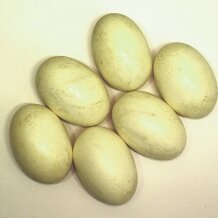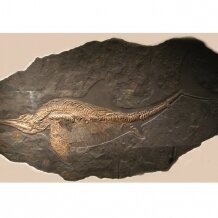Topic: Viviparity in ichthyosaurs
Categories: Reptiles, Sex & Reproduction
“For me, the fossil is a transporting piece of evidence. It shows a female ichthyosaur that died late in pregnancy or perhaps while giving birth; the baby was entombed with its mother in the mud.” J. Rennie (2000) Scientific American, vol. 283(6), p.8
Oviparity and viviparity
Forms of vertebrate reproduction can be divided into either 'oviparous' (egg-laying) or 'viviparous' (live-bearing), as first described by Aristotle in his Historia Animalium.  In egg-laying species, the developing embryo obtains nutrients from a store of yolk (termed 'lecithotrophy'), whereas viviparity is a broad term encompassing varied divergence from simple egg retention in the female oviduct to elaboration of complex placental structures between fetal and maternal tissues. During viviparous gestation, embryos may acquire nutrients by digestion of ovum yolk ('lecithotrophy'), intake of nutrients transferred from the mother ('matrotrophy'), or - in certain viviparous amphibians and fish only - by consuming sibling ova or embryos in utero. Current evidence suggests that genetic and phenotypic changes essential to acquiring viviparity strongly (but not absolutely) resist reversal to oviparity. Accordingly, in this case of evolution, not only is the direction of the "tape of life" very much determined, but it is very difficult to rewind.
In egg-laying species, the developing embryo obtains nutrients from a store of yolk (termed 'lecithotrophy'), whereas viviparity is a broad term encompassing varied divergence from simple egg retention in the female oviduct to elaboration of complex placental structures between fetal and maternal tissues. During viviparous gestation, embryos may acquire nutrients by digestion of ovum yolk ('lecithotrophy'), intake of nutrients transferred from the mother ('matrotrophy'), or - in certain viviparous amphibians and fish only - by consuming sibling ova or embryos in utero. Current evidence suggests that genetic and phenotypic changes essential to acquiring viviparity strongly (but not absolutely) resist reversal to oviparity. Accordingly, in this case of evolution, not only is the direction of the "tape of life" very much determined, but it is very difficult to rewind.
Viviparity in reptiles and other vertebrates
Viviparity has evolved more than 120 times in vertebrates, and surprisingly almost all of the transitions from oviparity to viviparity have occurred in the reptiles - the remaining occurrences being restricted to a few fish (sharks and rays), amphibians (certain salamanders and caecilians) and the well-known eutherian mammals, which are characterised by highly specialised placental structures for fetal nutrition. Over 85% of reptile species are oviparous, and yet viviparity has evolved convergently over 100 times. Most of these independent events have occurred in squamates (lizards, snakes and amphisbaenians), but the fossil record of ichthyosaurs, sauropterygians (best known, perhaps, for the plesiosaurs) and mosasaurs clearly indicates that live birth also evolved in several disparate lineages of Mesozoic marine reptiles. Here we focus on the ichthyosaurs...
Viviparity in ichthyosaurs
Ichthyosaurs were marine reptiles of 2 – 4m average length, although some species were very large,  growing up to 15 or 20m long (e.g. Shonisaurus popularis). The shape of these creatures converged markedly with fish such as sharks and tuna, and also with mammals such as dolphins : with their streamlined form, sharp teeth and large eyes it is likely that they were fast-moving predators, hunting in dim light and potentially at great depth. Ichthyosaurs lived throughout the Mesozoic era, from the Early Triassic to the Late Cretaceous. In parallel with the dinosaurs on land, their period of peak ecological dominance and diversity was the late Triassic – Early Jurassic, a time when the well-known Ichthyosaurus was at large.
growing up to 15 or 20m long (e.g. Shonisaurus popularis). The shape of these creatures converged markedly with fish such as sharks and tuna, and also with mammals such as dolphins : with their streamlined form, sharp teeth and large eyes it is likely that they were fast-moving predators, hunting in dim light and potentially at great depth. Ichthyosaurs lived throughout the Mesozoic era, from the Early Triassic to the Late Cretaceous. In parallel with the dinosaurs on land, their period of peak ecological dominance and diversity was the late Triassic – Early Jurassic, a time when the well-known Ichthyosaurus was at large.
 Fossils of pregnant females belonging to a number of ichthyosaur species have been found, and remarkable preservation of embryos inside these specimens shows that they gave birth to live young, avoiding the need to come ashore to lay eggs. Within Lower Jurassic rocks in Germany, hundreds of specimens of female Stenopterygius were discovered, containing embryos at various stages of development and apparently held within paired, elongate uteri. An exciting find in Lower Cretaceous rocks of NW Canada revealed both the latest and smallest ichthyosaur embryos known, and confirmed the fact that embryo development involves uncurling from a fetal position to a position in which increasingly thick (‘ossified’) and stiffened vertebrae come to lie parallel to the female vertebral column, the head directed anterior-ward.
Fossils of pregnant females belonging to a number of ichthyosaur species have been found, and remarkable preservation of embryos inside these specimens shows that they gave birth to live young, avoiding the need to come ashore to lay eggs. Within Lower Jurassic rocks in Germany, hundreds of specimens of female Stenopterygius were discovered, containing embryos at various stages of development and apparently held within paired, elongate uteri. An exciting find in Lower Cretaceous rocks of NW Canada revealed both the latest and smallest ichthyosaur embryos known, and confirmed the fact that embryo development involves uncurling from a fetal position to a position in which increasingly thick (‘ossified’) and stiffened vertebrae come to lie parallel to the female vertebral column, the head directed anterior-ward.  It is widely proposed that ichthyosaur offspring were born tail-first (to prevent drowning in a creature that needs to breathe air frequently, as is the case for cetaceans and sirenians), but this point is still debated.
It is widely proposed that ichthyosaur offspring were born tail-first (to prevent drowning in a creature that needs to breathe air frequently, as is the case for cetaceans and sirenians), but this point is still debated.
Ichthyosaurs and other marine reptiles (together called the Euryapsida) are most closely related to the Lepidosauria, a group containing the squamates (lizards, snakes, amphisbaenians) and rhynchocephalians or ‘tuataras’ (rather curious lizards endemic to New Zealand). The ancestors of euryapsids and lepidosaurs diverged from one another more than 250 million years ago, and separate lineages evolved viviparous gestation as a mode of reproduction on multiple independent occasions. Evidence for viviparity is rarely preserved in the fossil record, however, and in this context the discovery of pregnant female ichthyosaurs (including some specimens hypothesised to have died while giving birth) represents the earliest indisputable evidence for the evolution of viviparity in reptiles. The existence of viviparity in the Ichthyosauria, as well as in other marine reptiles and many squamate lineages highlights the importance of reptilian viviparity as a case study in convergent evolution.
Cite this web page
Map of Life - "Viviparity in ichthyosaurs"
https://mapoflife.org/topics/topic_333_Viviparity-in-ichthyosaurs/
September 19, 2015
(Topic created 11th September 2008) | Last modified: 16th October 2009
Please note: words or phrases shown in bold in the PRINT VERSION of this text normally indicate hyperlinks on the webpage. These generally return a list of search results based on that keyword.